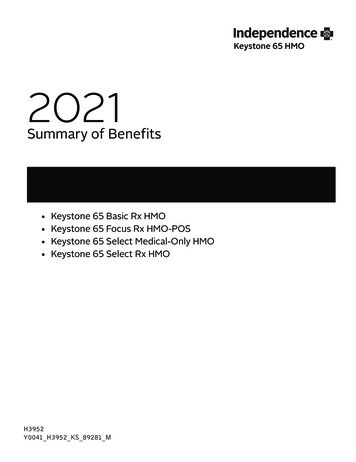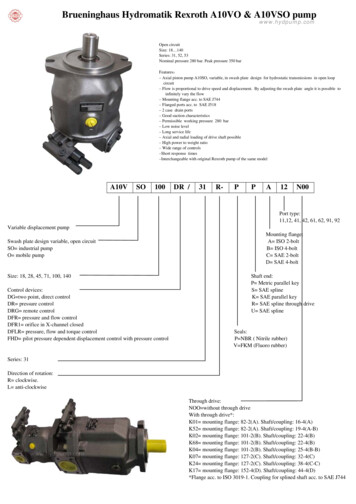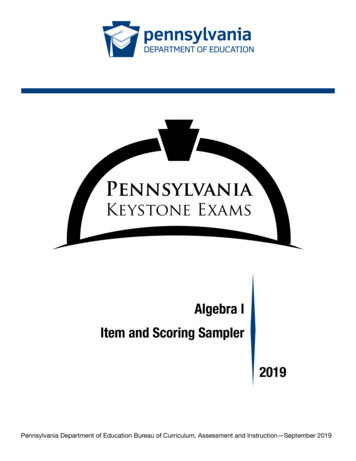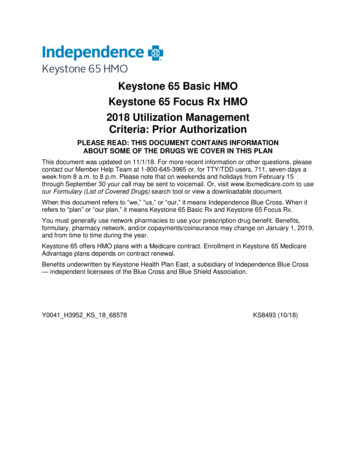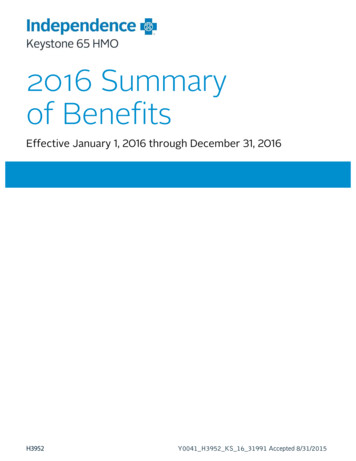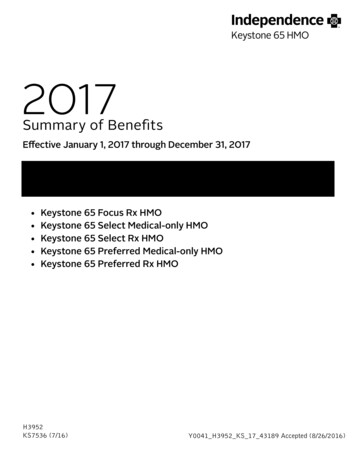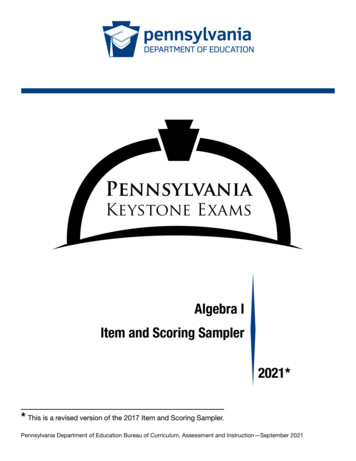
Transcription
PennsylvaniaKeystone ExamsAlgebra IItem and Scoring Sampler2021** This is a revised version of the 2017 Item and Scoring Sampler.Pennsylvania Department of Education Bureau of Curriculum, Assessment and Instruction—September 2021
TABLE OF CONTENTSINFORMATION ABOUT ALGEBRA IIntroduction . . . . . . . . . . . . . . . . . . . . . . . . . . . . . . . . . . . . . . . . . . . . . . . . . . . . . . . . . . . . . . . . . 1General Introduction . . . . . . . . . . . . . . . . . . . . . . . . . . . . . . . . . . . . . . . . . . . . . . . . . . . . . . . 1About the Keystone Exams . . . . . . . . . . . . . . . . . . . . . . . . . . . . . . . . . . . . . . . . . . . . . . . . . . . . . 1Alignment . . . . . . . . . . . . . . . . . . . . . . . . . . . . . . . . . . . . . . . . . . . . . . . . . . . . . . . . . . . . . . . 2Depth of Knowledge . . . . . . . . . . . . . . . . . . . . . . . . . . . . . . . . . . . . . . . . . . . . . . . . . . . . . . . 2Exam Format . . . . . . . . . . . . . . . . . . . . . . . . . . . . . . . . . . . . . . . . . . . . . . . . . . . . . . . . . . . . . 2Item and Scoring Sampler Format . . . . . . . . . . . . . . . . . . . . . . . . . . . . . . . . . . . . . . . . . . . . . . . . 3Algebra I Exam Directions . . . . . . . . . . . . . . . . . . . . . . . . . . . . . . . . . . . . . . . . . . . . . . . . . . . . . . 4General Description of Scoring Guidelines for Algebra I . . . . . . . . . . . . . . . . . . . . . . . . . . . . . . . 6Formula Sheet . . . . . . . . . . . . . . . . . . . . . . . . . . . . . . . . . . . . . . . . . . . . . . . . . . . . . . . . . . . . . . . 7ALGEBRA I MODULE 1 . . . . . . . . . . . . . . . . . . . . . . . . . . . . . . . . . . . . . . . . . . . . . . . . . . . . . . . . . . . . 8Multiple-Choice Items . . . . . . . . . . . . . . . . . . . . . . . . . . . . . . . . . . . . . . . . . . . . . . . . . . . . . . . . . 8Constructed-Response Item . . . . . . . . . . . . . . . . . . . . . . . . . . . . . . . . . . . . . . . . . . . . . . . . . . . 22Constructed-Response Item . . . . . . . . . . . . . . . . . . . . . . . . . . . . . . . . . . . . . . . . . . . . . . . . . . . 36Algebra I Module 1—Summary Data . . . . . . . . . . . . . . . . . . . . . . . . . . . . . . . . . . . . . . . . . . . . . 52ALGEBRA I MODULE 2 . . . . . . . . . . . . . . . . . . . . . . . . . . . . . . . . . . . . . . . . . . . . . . . . . . . . . . . . . . . 54Multiple-Choice Items . . . . . . . . . . . . . . . . . . . . . . . . . . . . . . . . . . . . . . . . . . . . . . . . . . . . . . . . 54Constructed-Response Item . . . . . . . . . . . . . . . . . . . . . . . . . . . . . . . . . . . . . . . . . . . . . . . . . . . 74Constructed-Response Item . . . . . . . . . . . . . . . . . . . . . . . . . . . . . . . . . . . . . . . . . . . . . . . . . . . 90Algebra I Module 2—Summary Data . . . . . . . . . . . . . . . . . . . . . . . . . . . . . . . . . . . . . . . . . . . . 104Keystone Algebra I Item and Scoring Sampler—September 2021ii
INFORMATION ABOUT ALGEBRA IINTRODUCTIONGeneral IntroductionThe Pennsylvania Department of Education (PDE) provides districts and schools with tools to assistin delivering focused instructional programs aligned to the Pennsylvania Core Standards. Thesetools include the standards, assessment anchor documents, Keystone Exams Test Definition,Classroom Diagnostic Tool, Standards Aligned System, and content-based item and scoringsamplers. This 2021 Algebra I Item and Scoring Sampler is a useful tool for Pennsylvania educatorsin preparing students for the Keystone Exams by providing samples of test item types and scoredstudent responses. The Item Sampler is not designed to be used as a pretest, a curriculum, or otherbenchmark for operational testing.This Item and Scoring Sampler contains released operational multiple-choice and constructedresponse items that have appeared on previously administered Keystone Exams. These items willnot appear on any future Keystone Exams. Released items provide an idea of the types of items thathave appeared on operational exams and that will appear on future operational Keystone Exams.Each item has been through a rigorous review process to ensure alignment with the AssessmentAnchors and Eligible Content. This sampler includes items that measure a variety of AssessmentAnchor or Eligible Content statements, but it does not include sample items for all AssessmentAnchor or Eligible Content statements.Typically an item and scoring sampler is released every year to provide students and educatorswith a resource to assist in delivering focused instructional programs aligned to the PCS. However,due to the cancellation of standardized testing in 2019–2020, the 2021 Item and Scoring Sampleris a revised version of the previously released 2017 Item and Scoring Sampler. This revised versionensures that students and educators have an enhanced item and scoring sampler to use duringinstruction and/or preparation of students to take the Keystone Exam.The items in this sampler may be used1 as samples of item types that students will encounter inoperational testing. Classroom teachers may find it beneficial to have students respond to theconstructed-response items in this sampler. Educators can then use the sampler as a guide to scorethe responses either independently or together with colleagues.This Item and Scoring Sampler is available in Braille format. For more information regarding Braillecall (717)-901-2238.ABOUT THE KEYSTONE EXAMSThe Keystone Exams are end-of-course assessments currently designed to assess proficienciesin Algebra I, Biology, and Literature. For detailed information about how the Keystone Exams arebeing integrated into the Pennsylvania graduation requirements, please contact the PennsylvaniaDepartment of Education or visit the PDE website at http://www.education.pa.gov.1The permission to copy and/or use these materials does not extend to commercial purposes.Keystone Algebra I Item and Scoring Sampler—September 20211
INFORMATION ABOUT ALGEBRA IAlignmentThe Algebra I Keystone Exam consists of questions grouped into two modules:Module 1—Operations and Linear Equations & Inequalities and Module 2—Linear Functions andData Organizations. Each module corresponds to specific content, aligned to statements andspecifications included in the course-specific Assessment Anchor documents. The Algebra I contentincluded in the Keystone Algebra I multiple-choice items will align with the Assessment Anchors asdefined by the Eligible Content statements. The process skills, directives, and action statements willalso specifically align with the Assessment Anchors as defined by the Eligible Content statements.The content included in Algebra I constructed-response items aligns with content included inthe Eligible Content statements. The process skills, directives, and action statements included inthe performance demands of the Algebra I constructed-response items align with specificationsincluded in the Assessment Anchor statements, the Anchor Descriptor statements, and/or theEligible Content statements. In other words, the verbs or action statements used in the constructedresponse items or stems can come from the Eligible Content, Anchor Descriptor, or AssessmentAnchor statements.Depth of KnowledgeWebb’s Depth of Knowledge (DOK) was created by Dr. Norman Webb of the Wisconsin Centerfor Education Research. Webb’s definition of depth of knowledge is the cognitive expectationdemanded by standards, curricular activities, and assessment tasks. Webb’s DOK includes fourlevels, from the lowest (basic recall) level to the highest (extended thinking) level.Level 1Level 2Level 3Level 4Depth of KnowledgeRecallBasic Application of Skill/ConceptStrategic ThinkingExtended ThinkingEach Keystone item has been through a rigorous review process and is assigned a DOK level.For additional information about depth of knowledge, please visit the PDE website at e Exams Understanding Depth of Knowledge andCognitive Complexity.pdf.Exam FormatThe Keystone Exams are delivered in a paper-and-pencil format as well as in a computer-basedonline format. The multiple-choice items require students to select the best answer from fourpossible answer options and record their answers in the spaces provided. The correct answer foreach multiple-choice item is worth one point. The constructed-response items require studentsto develop and write (or construct) their responses. Constructed-response items in Algebra I arescored using item-specific scoring guidelines based on a 0–4-point scale. Each multiple-choice itemis designed to take about one to one-and-a-half minutes to complete. Each constructed-responseitem is designed to take about 10 minutes to complete. The estimated time to respond to a testquestion is the same for both test formats. During an actual exam administration, students are givenadditional time as necessary to complete the exam.Keystone Algebra I Item and Scoring Sampler—September 20212
INFORMATION ABOUT ALGEBRA IITEM AND SCORING SAMPLER FORMATThis sampler includes the test directions, scoring guidelines, and formula sheet that appear inthe Keystone Exams. Each sample multiple-choice item is followed by a table that includes thealignment, the answer key, the DOK, the percentage2 of students who chose each answer option,and a brief answer option analysis or rationale. Each constructed-response item is followed by atable that includes the alignment, the DOK, and the mean student score. Additionally, each of theincluded item-specific scoring guidelines is combined with sample student responses representingeach score point to form a practical, item-specific scoring guide. The General Description of ScoringGuidelines for Algebra I used to develop the item-specific scoring guidelines should be used if anyadditional item-specific scoring guidelines are created for use within local instructional programs.Example Multiple-Choice Item Information TableItem InformationAlignmentAssigned AAECAnswer KeyCorrect AnswerDepth of KnowledgeAssigned DOKp-value APercentage of students who selected each optionp-value BPercentage of students who selected each optionp-value CPercentage of students who selected each optionp-value DPercentage of students who selected each optionOption AnnotationsBrief answer option analysis or rationaleExample Constructed-Response Item Information TableAlignment2AssignedAAECDepth ofKnowledgeAssignedDOKMean ScoreAll p-value percentages listed in the item information tables have been rounded.Keystone Algebra I Item and Scoring Sampler—September 20213
INFORMATION ABOUT ALGEBRA IALGEBRA I EXAM DIRECTIONSDirections:Below are the exam directions available to students. These directions may be used to help studentsnavigate through the exam.Formulas that you may need to solve questions in this module are found on page 7 of this testbooklet. You may refer to the formula page at any time during the exam.You may use a calculator on this module. When performing operations with π (pi), you may use eithercalculator π or the number 3.14 as an approximation of π.There are two types of questions in each module.Multiple-Choice Questions:These questions will ask you to select an answer from among four choices. First read the question and solve the problem on scratch paper. Then choose thecorrect answer. Only one of the answers provided is correct. If none of the choices matches your answer, go back and check your work forpossible errors. Record your answer in the Algebra I answer booklet.Constructed-Response Questions:These questions will require you to write your response. These questions have more than one part. Be sure to read the directions carefully. You cannot receive the highest score for a constructed-response question withoutcompleting all the tasks in the question. If the question asks you to show your work or explain your reasoning, be sure to showyour work or explain your reasoning. However, not all questions will require that youshow your work or explain your reasoning. If the question does not require that youshow your work or explain your reasoning, you may use the space provided for yourwork or reasoning, but the work or reasoning will not be scored. All responses must be written in the appropriate location within the response box in theAlgebra I answer booklet. Some answers may require graphing, plotting, labeling,drawing, or shading. If you use scratch paper to write your draft, be sure to transferyour final response to the Algebra I answer booklet.Keystone Algebra I Item and Scoring Sampler—September 20214
INFORMATION ABOUT ALGEBRA IIf you finish early, you may check your work in Module 1 [or Module 2] only . Do not look ahead at the questions in Module 2 [or back at the questions in Module 1] ofyour exam materials. After you have checked your work, close your exam materials.You may refer to this page at any time during this portion of the exam.Keystone Algebra I Item and Scoring Sampler—September 20215
INFORMATION ABOUT ALGEBRA IGENERAL DESCRIPTION OF SCORING GUIDELINES FOR ALGEBRA I4 Points The response demonstrates a thorough understanding of the mathematical concepts andprocedures required by the task. The response provides correct answer(s) with clear and complete mathematical proceduresshown and a correct explanation, as required by the task. Response may contain a minor“blemish” or omission in work or explanation that does not detract from demonstrating athorough understanding.3 Points The response demonstrates a general understanding of the mathematical concepts andprocedures required by the task. The response and explanation (as required by the task) are mostly complete and correct.The response may have minor errors or omissions that do not detract from demonstrating ageneral understanding.2 Points The response demonstrates a partial understanding of the mathematical concepts andprocedures required by the task. The response is somewhat correct with partial understanding of the required mathematicalconcepts and/or procedures demonstrated and/or explained. The response may containsome work that is incomplete or unclear.1 Point The response demonstrates a minimal understanding of the mathematical concepts andprocedures required by the task.0 Points The response has no correct answer and insufficient evidence to demonstrate anyunderstanding of the mathematical concepts and procedures required by the task.Keystone Algebra I Item and Scoring Sampler—September 20216
INFORMATION ABOUT ALGEBRA IFORMULA SHEETALGEBRA I FORMULA SHEETFormulas that you may need to solve questions on this exam are found below.You may use calculator π or the number 3.14 as an approximation of π.Arithmetic PropertiesA lwwlAdditive Inverse:a (ˉa) 0Multiplicative Inverse:Commutative Property:a·1 1aa b b aa ·b b ·aV lwhAssociative Property:Identity Property:Linear EquationsSlope:m Point-Slope Formula:a 0 aa ·1 aDistributive Property:y2 – y1x2 – x1(y – y 1) m(x – x 1)Slope-Intercept Formula:y mx bStandard Equation of a Line:Ax By CKeystone Algebra I Item and Scoring Sampler—September 2021(a b) c a (b c)(a · b) · c a · (b · c)a · (b c) a · b a · cMultiplicative Property of Zero:a ·0 0Additive Property of Equality:If a b, then a c b cMultiplicative Property of Equality:If a b, then a · c b · c7
1Algebra IMODULE 1ALGEBRA I MODULE 1MULTIPLE-CHOICE ITEMS1 .Four expressions are shown below. xx21xx2Which inequality comparing two of the expressions is true when 0.1 x 0.4? x2A. xB.xx2 2C.1x xD.1x 2 xItem InformationAlignmentA1.1.1.1.1Answer KeyADepth of Knowledge2p-value A33% (correct answer)p-value B29%p-value C18%p-value D20%Option AnnotationsA student could determine the correct answer, option A, by substituting0.1 in for x. Of the given answer choices, only option A is true at 0.1.A student could arrive at an incorrect answer by using one or more testvalues outside the given range. For example, the student could arrive atoption B by testing values greater than 0.5.Keystone Algebra I Item and Scoring Sampler—September 20218
Algebra I2 .1MODULE 1The greatest common factor (GCF) of x3yk and x2ky4 is x3y3. What is the value of k?A.1B.2C.3D.4674148Item InformationAlignmentA1.1.1.2.1Answer KeyCDepth of Knowledge2p-value A26%p-value B15%p-value C52% (correct answer)p-value D7%Option AnnotationsA student could determine the correct answer, option C, by determiningthat 3 must be the minimum exponent of y (i.e., the minimum of kand 4), which means the value of k must be 3.A student could arrive at an incorrect answer by applying incorrectreasoning about the GCF of monomials. For example, a student couldarrive at option A by interpreting the exponents of y to mean 4 – k 3.Keystone Algebra I Item and Scoring Sampler—September 20219
1Algebra I3 .MODULE 1( )4 x8?Which equation correctly shows that x2A.(x2)4 (x2)(x4) x8B.(x2)4 4(2x) 8x x8C.(x2)4 4(x2) x2 x2 x2 x2 x8D.(x2)4 (x2)(x2)(x2)(x2) x x x x x x x x x8Item InformationAlignmentA1.1.1.3.1Answer KeyDDepth of Knowledge1p-value A27%p-value B6%p-value C9%p-value D58% (correct answer)Option AnnotationsA student could determine the correct answer, option D, by applyingthe properties of exponents. Of the given answer choices, only(x2)4 (x2)(x2)(x2)(x2) x x x x x x x x x8 correctly followsthe properties of exponents.A student could arrive at an incorrect answer by incorrectly applyingthe properties of exponents. For example, a student could arriveat option A by interpreting a coefficient to a power times the samecoefficient to a power as meaning that the two exponents can bemultiplied to generate an equivalent value.Keystone Algebra I Item and Scoring Sampler—September 202110
Algebra I4 .1MODULE 1When factored completely, which is a factor of 6x3 – 12x2 – 48x?A.(x 2)B.(x 4)C.(2x – 3)D.(2x – 4)640579Item InformationAlignmentA1.1.1.5.2Answer KeyADepth of Knowledge1p-value A35% (correct answer)p-value B16%p-value C25%p-value D24%Option AnnotationsA student could determine the correct answer, option A, by factoringthe given expression: 6x3 – 12x2 – 48x 6x(x2 – 2x – 8) 6x(x 2)(x – 4).Of the given answer options, only (x 2) is one of the factors of theoriginal expression.A student could arrive at an incorrect answer by incorrectly factoringthe given expression. For example, a student could arrive at option Cby factoring out 2x from each term and subtracting the coefficient of x2from 2x.Keystone Algebra I Item and Scoring Sampler—September 202111
Algebra I5 .1MODULE 1Anna’s Bakery charges a delivery fee of 10.95 for one delivery order of cupcakes. Eachcupcake in the order costs 1.15. Which equation describes the relationship between thenumber of cupcakes ordered (x) and the total cost (y), in dollars, of the delivery order?A.y 1.15xB.y 12.10xC.y 1.15x 10.95D.y 10.95x 1.15674427Item InformationAlignmentA1.1.2.1.1Answer KeyCDepth of Knowledge2p-value A6%p-value B4%p-value C82% (correct answer)p-value D8%Option AnnotationsA student could determine the correct answer, option C, by reasoningthat the total cost is equal to the price per cupcake times the numberof cupcakes plus the delivery fee. Of the given answer options, onlyy 1.15x 10.95 matches this description.A student could arrive at an incorrect answer by incorrectly interpretingthe meaning of the delivery fee and the cost per cupcake. For example,a student could arrive at option D by switching the meaning of thetwo values, multiplying the number of cupcakes by the delivery fee andadding the cost per cupcake one time.Keystone Algebra I Item and Scoring Sampler—September 202112
Algebra I6 .1MODULE 1Kylie and Rhoda are solving the equation 4(x – 8) 7(x – 4). Kylie uses a first step that results in 4x – 32 7x – 28.Rhoda uses a first step that results in 4x – 8 7x – 4.Which statement about the first steps Kylie and Rhoda use is true?A.Kylie uses the associative property, resulting in a correct first step.B.Kylie uses the distributive property, resulting in a correct first step.C.Rhoda uses the associative property, resulting in a correct first step.D.Rhoda uses the distributive property, resulting in a correct first step.674448Item InformationAlignmentA1.1.2.1.2Answer KeyBDepth of Knowledge1p-value A7%p-value B84% (correct answer)p-value C5%p-value D4%Option AnnotationsA student could arrive at the correct answer, option B, by correctlydistributing both sides of the given equation to 4x – 32 7x – 28and correctly identifying the property used to justify this step as thedistributive property.A student could arrive at an incorrect answer by incorrectly identifyingthe property being used. For example, a student could arrive at option Aby recognizing that Kylie uses a correct first step but using the incorrectproperty to explain why the step is correct.Keystone Algebra I Item and Scoring Sampler—September 202113
Algebra I7 .1MODULE 1Darlene is collecting prize tickets. The equation y 2x 1 describes the relationship betweenthe number of days (x) since she began collecting and the number of prize tickets (y) she hascollected. Which statement correctly describes a solution of the equation?A.Darlene has collected 2 prize tickets at the end of 1 day.B.Darlene has collected 4 prize tickets at the end of 9 days.C.Darlene has collected 22 prize tickets at the end of 10 days.D.Darlene has collected 25 prize tickets at the end of 12 days.640576Item InformationAlignmentA1.1.2.1.3Answer KeyDDepth of Knowledge2p-value A27%p-value B12%p-value C7%p-value D54% (correct answer)Option AnnotationsA student could determine the correct answer, option D, by substitutingthe given numbers of days for x in the given equation and determiningwhich number of days is correctly paired with a number of tickets.Of the given answer options, only option D gives a correct pair:2(12) 1 25.A student could arrive at the incorrect answer by incorrectly interpretingthe given equation. For example, a student could arrive at option A bysubstituting 1 for x and not adding the 1 because only one day haspassed.Keystone Algebra I Item and Scoring Sampler—September 202114
Algebra I8 .1MODULE 1Mary measured the heights of two different plants every day. Plant A was 1 inch tall whenMary began her measuring, and it grew 0.5 inch per day. Plant B was 3 inches tall, and it grew0.25 inch per day. On which day were plant A and plant B the same height?A.day 5B.day 8C.day 12D.day 16640597Item InformationAlignmentA1.1.2.2.1Answer KeyBDepth of Knowledge2p-value A9%p-value B75% (correct answer)p-value C11%p-value D5%Option AnnotationsA student could determine the correct answer, option B, bycreating expressions for the height of each plant after x days(1 0.5x and 3 0.25x), setting the two expressions equal to each other(1 0.5x 3 0.25x), and then solving for x (0.25x 2; x 8).A student could arrive at an incorrect answer by using an incorrectstarting height. For example, a student could arrive at option C byleaving out the 1 inch starting height of the first plant, treating thesituation as if the first plant started with a height of 0 inches.Keystone Algebra I Item and Scoring Sampler—September 202115
1Algebra I9 .MODULE 1Which graph shows the solution set of the inequality 2x – 7 3?A. 5 4 3 2 1012345 5 4 3 2 1012345 5 4 3 2 1012345 5 4 3 2 1012345B.C.D.681810Item InformationAlignmentA1.1.3.1.1Answer KeyADepth of Knowledge1p-value A43% (correct answer)p-value B27%p-value C19%p-value D11%Option AnnotationsA student could determine the correct answer, option A, by convertingthe given inequality to a pair of inequalities (2x – 7 3 or 2x – 7 ˉ 3),then solving both inequalities for x (2x 10, so x 5; 2x 4, so x 2),and correctly identifying the corresponding graph on the number lines.A student could arrive at an incorrect answer by converting the giveninequality to a compound inequality using the same operator for bothcomparisons. For example, a student could arrive at option B bychanging the given inequality to a compound inequality using only lessthan comparisons (ˉ 3 2x – 7 3).Keystone Algebra I Item and Scoring Sampler—September 202116
1Algebra IMODULE 110 . The solution set of an inequality is shown below. 6 4 20246Which inequality has the solution set shown in the graph?A.x ˉ1ˉ4 2B.x 1ˉ4 2C.x ˉ14 2D.x 14 2674391Item InformationAlignmentA1.1.3.1.2Answer KeyDDepth of Knowledge2p-value A11%p-value B10%p-value C12%p-value D67% (correct answer)Option AnnotationsA student could determine the correct answer, option D, by solving theinequalities in the answer options. Of the given answer options, onlyoption D results in an inequality that matches the inequality shown onthe number line (by multiplying both sides by 4, arrive at x 2).A student could arrive at an incorrect answer by incorrectly workingwith negative signs. For example, a student could arrive at option Aby multiplying both sides of the inequality by ˉ 1 but not reversing theinequality in the process.Keystone Algebra I Item and Scoring Sampler—September 202117
Algebra I1MODULE 111 . A T-shirt company has a goal to earn a monthly profit of more than 3,500. The company charges 20 per T-shirt.The company has 1,500 in monthly costs.The inequality 20x – 1,500 3,500 models this situation. Which best describes the meaning ofx in the inequality?A.the profit made from the sale of 20 T-shirtsB.the profit made from 1 month of T-shirt salesC.the number of T-shirts that need to be sold for the company to meet its goalD.the number of T-shirts that need to be sold for the company to recover its monthly costs674490Item InformationAlignmentA1.1.3.1.3Answer KeyCDepth of Knowledge2p-value A8%p-value B9%p-value C68% (correct answer)p-value D15%Option AnnotationsA student could determine the correct answer, option C, by correctlyinterpreting the inequality. The 20 represents the sale price of eachT-shirt, the x represents the number of T-shirts sold, the 1,500represents the monthly costs, and the 3,500 represents the goal. Whenassembled into the inequality, x represents the number of T-shirts thatneed to be sold to meet the goal.A student could arrive at an incorrect answer by misinterpretingthe meaning of the inequality. For example, a student could arrive atoption D by interpreting the inequality as representing the point whereexpenses are equal to income.Keystone Algebra I Item and Scoring Sampler—September 202118
Algebra I1MODULE 1THIS PAGE ISINTENTIONALLY BLANK.Keystone Algebra I Item and Scoring Sampler—September 202119
1Algebra IMODULE 112 . A system of inequalities is shown below.1y ˉ2x 3x 2y ˉ 2Which graph represents the system?A.B.y54321–5–4–3–2–11 2 3 4 5–1–2–3–4–5C.–5–4–3–2–11 2 3 4 5–1–2–3–4–554321x–5–4–3–2–11 2 3 4 5–1–2–3–4–5D.y54321yxKeystone Algebra I Item and Scoring Sampler—September 2021xy54321–5–4–3–2–11 2 3 4 5–1–2–3–4–5x20
Algebra I1MODULE 1Item InformationAlignmentA1.1.3.2.1Answer KeyCDepth of Knowledge2p-value A15%p-value B18%p-value C42% (correct answer)p-value D25%Option AnnotationsA student could determine the correct answer, option C, by determining1 x – 1.that the boundary lines of the solution are y ˉ1} x 3 and y ˉ}22Of the given answer options, only option C has these as the boundarylines of the solution region.A student could arrive at an incorrect answer by incorrectly determiningthe y-intercept for one of the boundary equations. For example, astudent could arrive at option D by using ˉ 2 as the y-intercept of thesecond equation.Keystone Algebra I Item and Scoring Sampler—September 202121
Algebra I1MODULE 1CONSTRUCTED-RESPONSE ITEM13 . Small baskets of tomatoes are sold at a vegetable stand for 3 per basket. Large basketsof tomatoes are sold at the stand for 5 per basket. Only whole numbers of baskets may bepurchased.A customer purchases a total of 8 baskets of tomatoes and pays 36.A .Write and solve a system of equations that models the number of smallbaskets (x) and the number of large baskets (y) that the customer purchases.Show or explain all your work.Go to the next page to finish question 13 .Keystone Algebra I Item and Scoring Sampler—September 2021GO ON22
Algebra I1MODULE 113 . Continued. Please refer to the previous page for task explanation.Another customer claims that he can purchase a total of 10 baskets of tomatoesand pay 45.B .Use a system of equations that describes this other customer’s purchase toexplain why the claim is incorrect.AFTER YOU HAVE CHECKED YOUR WORK, CLOSE YOUR ANSWERBOOKLET AND TEST BOOKLET SO YOUR TEACHER WILL KNOWYOU ARE FINISHED .Keystone Algebra I Item and Scoring Sampler—September 2021STOP23
Algebra I1MODULE 1Item-Specific Scoring Guideline#13 Item InformationAlignmentA1.1.2Depth ofKnowledge2Mean Score1.58Assessment Anchor this item will be reported under:A1 .1 .2—Linear EquationsSpecific Anchor Descriptor addressed by this item:A1 .1 .2 .2—Write, solve, and/or graph systems of linear equations using various methods.Scoring GuideScoreDescription4The student demonstrates a thorough understanding of linear equations by correctlysolving problems with clear and complete procedures and explanations when required.3The student demonstrates a general understanding of linear equations by solvingproblems and providing procedures and explanations with only minor errors oromissions.2The student demonstrates a partial understanding of linear equations by providing aportion of the correct problem solving, procedures, and explanations.1The student demonstrates a minimal understanding of linear equations.0The response has no correct answer and insufficient evidence to demonstrate anyunderstanding
This 2021 Algebra I Item and Scoring Sampler is a useful tool for Pennsylvania educators in preparing students for the Keystone Exams by providing samples of test item types and scored student responses. The Item Sampler is not designed to be used as a pretest, a curriculum, or other benchmark for operational testing.
